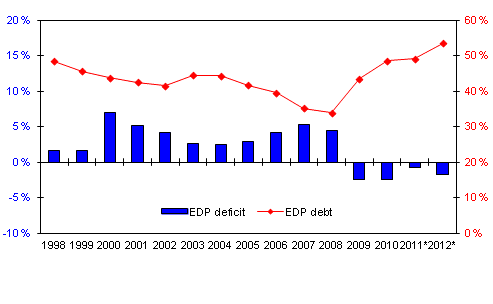Published: 30 September 2013
Revised general government deficit and debt figures for 2012 released
According to Statistics Finland’s revised preliminary data, the general government’s deficit amounted to EUR 3.4 billion, or 1.8 per cent relative to GDP in 2012. One year before the deficit was EUR 1.3 billion. The central government sector’s deficit grew by EUR 0.8 billion to EUR 6.6 billion in 2012. In turn, the local government sector's deficit increased from EUR 1.0 billion to EUR 2.1 billion. Social security funds, primarily employment pension schemes, accumulated a surplus of EUR 5.2 billion.
Finland's general government deficit (-) and debt, percentage of GDP

The amount of consolidated general government EDP debt increased by EUR 10.3 billion to EUR 103.1 billion during 2012. Central government debt grew by EUR 8.8 billion and local government debt by EUR 1.5 billion. At the same time, the GDP share of the debt grew to 53.6 per cent from the previous year’s 49.2 per cent. Internal general government debt decreased by some EUR 0.7 billion. The EDP debt describes general government’s debt to the other sectors of the economy and to the rest of the world, and its development is influenced by changes in both the unconsolidated gross debt and the internal general government debt.
Compared to the preliminary data for 2012 released in March 2013, total general government deficit decreased by EUR 0.2 billion. General government debt for 2012 remained almost unchanged in relation to the preliminary data, but due to the revision of GDP the GDP share of the debt increased by 0.6 per centage points.
In public sector accounts, the European Financial Stability Facility EFSF is, based on Eurostat's decision, handled so that EFSF's borrowing is recorded as part of the gross government debt of the countries that have provided guarantees. The loan received by the beneficiary country from EFSF is recorded as if it had been received from the countries in the euro area that have provided guarantees and these countries in turn owe the corresponding amount to EFSF. As a result, the EDP gross debt of the countries that provided guarantees grows but the net debt remains unchanged because the countries have a similar receivable from the beneficiary country. The gross government debt to be recorded for each country on the loans granted by EFSF is calculated by dividing the loan granted to the beneficiary country by the contribution key (based on the share in ECB's capital of each country participating in the support operations).
For 2012, Finland's general government debt includes EUR 2,702 million of debt granted by EFSF to beneficiary countries. At the end of 2011, the amount was EUR 312 million.
The public deficit and debt concept used in these statistics complies with the Excessive Deficit Procedure (EDP) of the European Union's Growth and Stability Pact. This EDP deficit corresponds with the net lending of the general government sector account in national accounts (ESA95), except for the interest flows relating to swap and forward rate agreements, which are entered as interest expenses in the EDP deficit report but as changes in derivative debt in national accounts. In 2012, the impact from the difference between the methods amounted to 0.4 per cent of GDP, and according to the revised preliminary data, general government net lending of the sector accounts compliant with ESA95 was -2.2 per cent of GDP.
The EDP debt of general government differs conceptionally to some extent, for example in terms of central government, from the central government debt published by the State Treasury. Central government's EDP debt includes loans granted to beneficiary countries by the European Financial Stability Facility EFSF (as explained above), received cash collaterals related to derivative contracts, the capital of the Nuclear Waste Management Fund, debts generated from investments in central government's PPP (public-private partnership) projects, and coins in circulation. In National Accounts, central government is also a broader concept than budget economy, in addition to which it includes, for example, universities and Solidium. When these differences are taken into consideration we reach the central government non-consolidated gross debt in accordance with the EDP concept (Appendix table 3), i.e. in 2012, the State Treasury's central government debt EUR 83.9 billion + conceptual differences of the debt EUR 9.9 billion + differences caused by the sector delimitation EUR 0.6 billion = central government non-consolidated gross debt EUR 94.4 billion. The valuation principle for both debt concepts is the nominal value, where the effect of currency swaps are taken into account.
The figures derive from the data reported by Statistics Finland to Eurostat in September. Eurostat will verify the deficit and debt figures reported by the Member States over the following weeks. In this process, changes may be made to the figures reported by Statistics Finland. In that case, the updated figures will be released on the pages of these statistics on 21 October, on the same day that Eurostat will publish the data.
Source: General government deficit and debt. Statistics Finland
Inquiries: Mira Lehmuskoski 09 1734 2708, Niina Suutarinen 09 1734 3302, financial.accounts@stat.fi
Director in charge: Leena Storgårds
Publication in pdf-format (254.5 kB)
- Tables
-
Tables in databases
Pick the data you need into tables, view the data as graphs, or download the data for your use.
Appendix tables
- Appendix table 1. General government EDP deficit 1997-2012 1) (30.9.2013)
- Appendix table 2. General government EDP debt 1997-2012 1) (30.9.2013)
- Appendix table 3. General government non-consolidated gross debt and EDP debt 2000-2012 1) (30.9.2013)
- EDP reporting tables, October 2013 notification (updated 30.9.2013) (Excel) (30.9.2013)
- Revisions in these statistics
-
- Revisions in these statistics (30.9.2013)
Updated 30.9.2013
Official Statistics of Finland (OSF):
General government deficit and debt [e-publication].
ISSN=1799-5914. 2012. Helsinki: Statistics Finland [referred: 19.4.2025].
Access method: http://stat.fi/til/jali/2012/jali_2012_2013-09-30_tie_001_en.html

